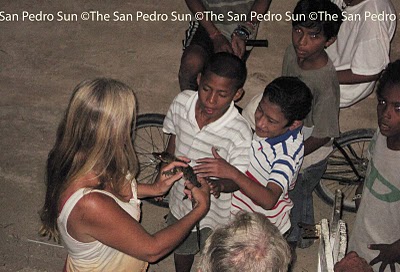You’re never too young to rescue crocodiles as young Alexis learned when he assisted ACES (American Crocodile Education Sanctuary) in the rescue and re-release of a four month old baby crocodile named “Larry” that he helped save. Baby crocs up to a year old are called “hatchlings,” explained Cherie Chenot-Rose, Biologist, as she and Animal Behaviorist Vince Rose informed Alexis about these threatened and protected modern day dinosaurs.

On this particular rainy day release on Nov. 19th, Vince decided to show Alexis how to properly handle the baby croc, and let him assist in re-releasing the baby croc he was instrumental in saving. When “Larry” was first rescued he was close to starvation and had to be forced fed twice and given vitamins before the little croc began eating on its own. When a Crocodilian is severely stressed, they will often refuse to eat. Crocs as large as 10 feet in length have been know to actually starve to death when subjected to high stress. This severe stress is usually due to improper husbandry, or care, and handling.
Baby croc Larry was lucky when Alexis properly and promptly contacted ACES and let them do their job. Now, a few months later, Larry is healthy, tagged and swimming free. “What most people do not realize is that less than 1% of the eggs in a crocodile’s nest will hatch and grow to reach a size at which they can reproduce, or sexual maturity,” states Chenot-Rose. Although the exact croc population on Ambergris Caye is currently undetermined, it is a know fact in the scientific community that it is the last stronghold for this keystone species.
ACES in Action
ACES has been busier than ever, with two other successful re-releases last weekend. “Crocoberry”, a 7 ft. 7” problematic male croc was rescued from the residence of Mr. & Mrs. Castleberry in San Pablo where he had taken up residence sunbathing in their canal-side backyard. The Castleberry’s had contacted ACES about their unwanted croc and treated the ACES team to a home cooked meal (complete with Wayne’s birthday cake) and cinnamon rolls to go in appreciation of their assistance.
The following day the team was called upon to relocate “Sampson,” an 8ft male croc, from the DFC area. “This was the most rewarding croc rescue so far,” stated Vince, “due to the tremendous amount of support and assistance from the DFC community.” Sampson’s rescue took 5 hours as he was extremely crafty at eluding croc wrangler Vince, who fearlessly crawled under houses in waist-deep waters in the dark. Finally lassoing Sampson, Vince found the croc to be a tagged ACES croc, proving that Sampson is a returning, problematic croc. Sampson was re-released for his final time. If captured again as a problematic animal, Sampson’s fate may be death. With nowhere else to place him, ACES and the Belize Forest Department cannot take the chance of him harming more pets or even worse, possibly a child.
Crocs on AmbergrisACES is currently conducting a croc population survey and size distribution on Ambergris Caye. “Although no grants have come through yet to fund our efforts we just can’t sit still, so we’re taking the opportunity to collect pertinent data during rescues,” states Cherie. Vince and Cherie have collected scientific data on all of the problem crocs being relocated as well as collecting date while conducting croc “eye-shine” surveys. The animals are humanly captured; data such as size, sex and general health are recorded, then tagged and released. When rescuing crocs, such as the previously tagged one from the DFC area, the information collected will allow ACES to write an extremely needed Crocodile Conservation Plan for the island and present their findings to the Belize Forest Dept.
While still waiting for a reply from various grant applications, including PACT, ACES really wishes they had a hand held GPS to be able to collect accurate sighting and croc locations. Regardless, the croc population study will continue. Vince and Cherie are overwhelmed at the respect and participation of all the local Croc Crusaders on Ambergris Caye and stated that this support is what motivates them to continue to move forward.
For more information about ACES or to report a problem croc please call 666-3871 or631-6366.
Cherie Chenot-Rose, ACES Biologist
Croc Crusaders



